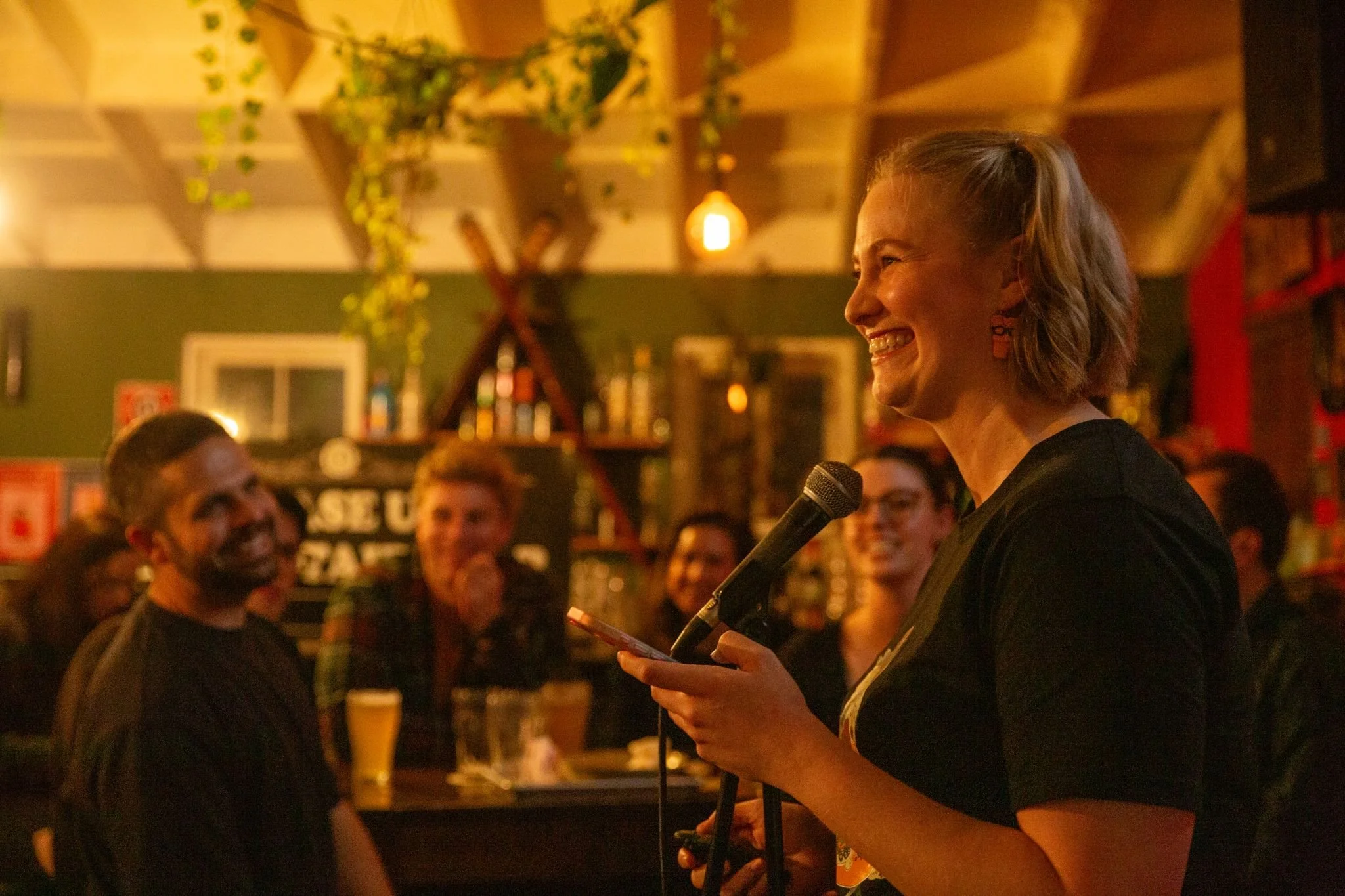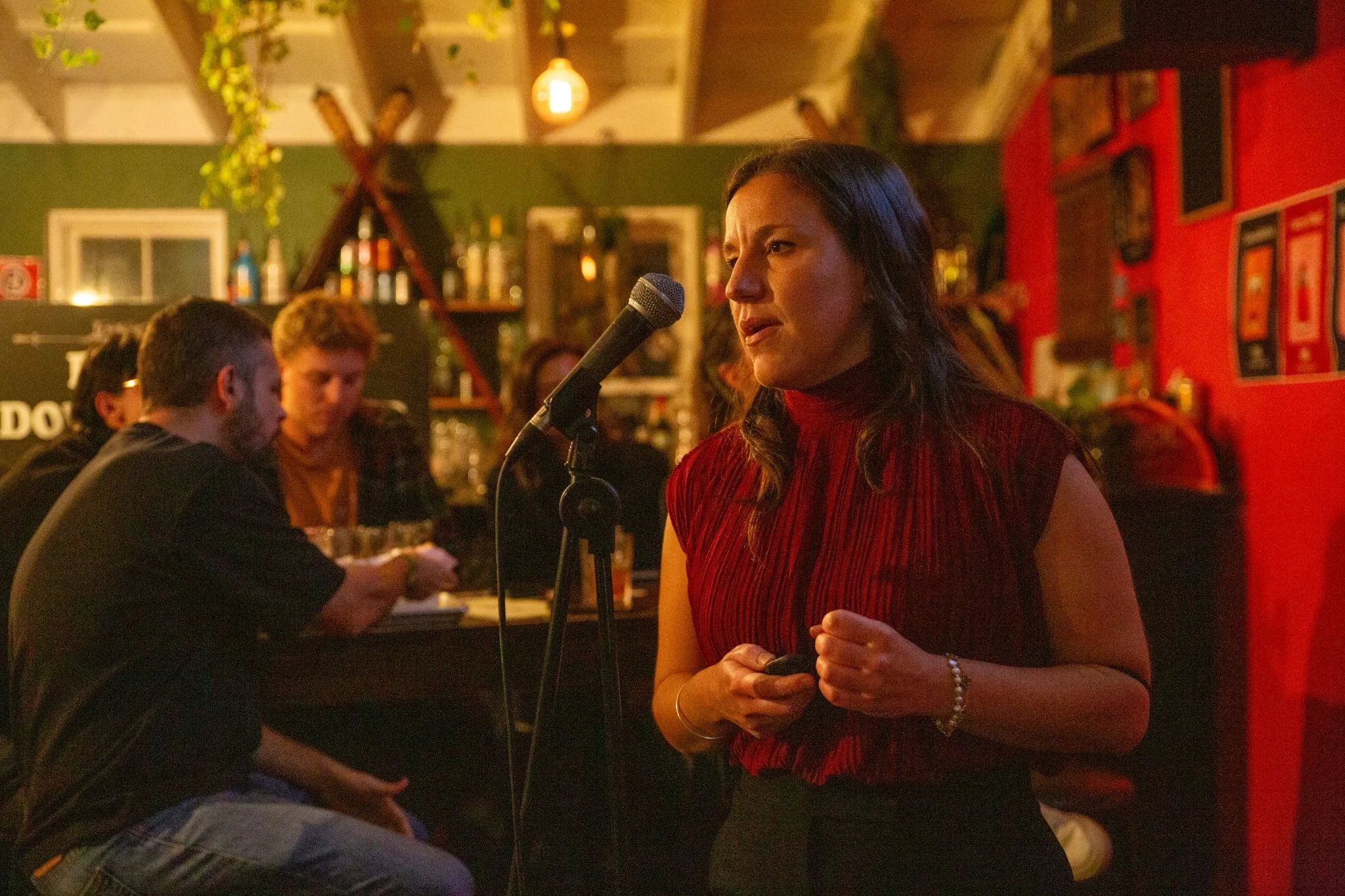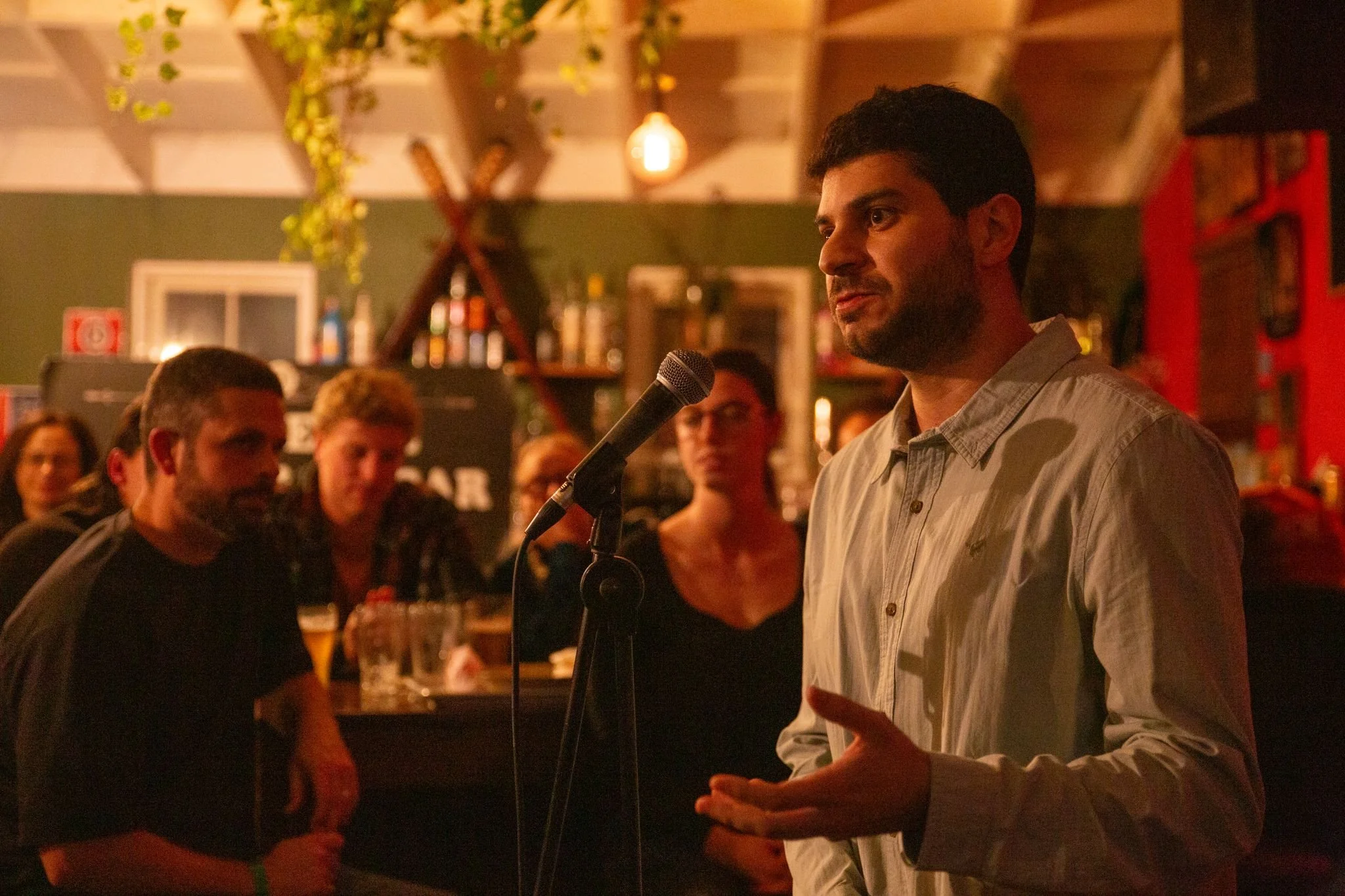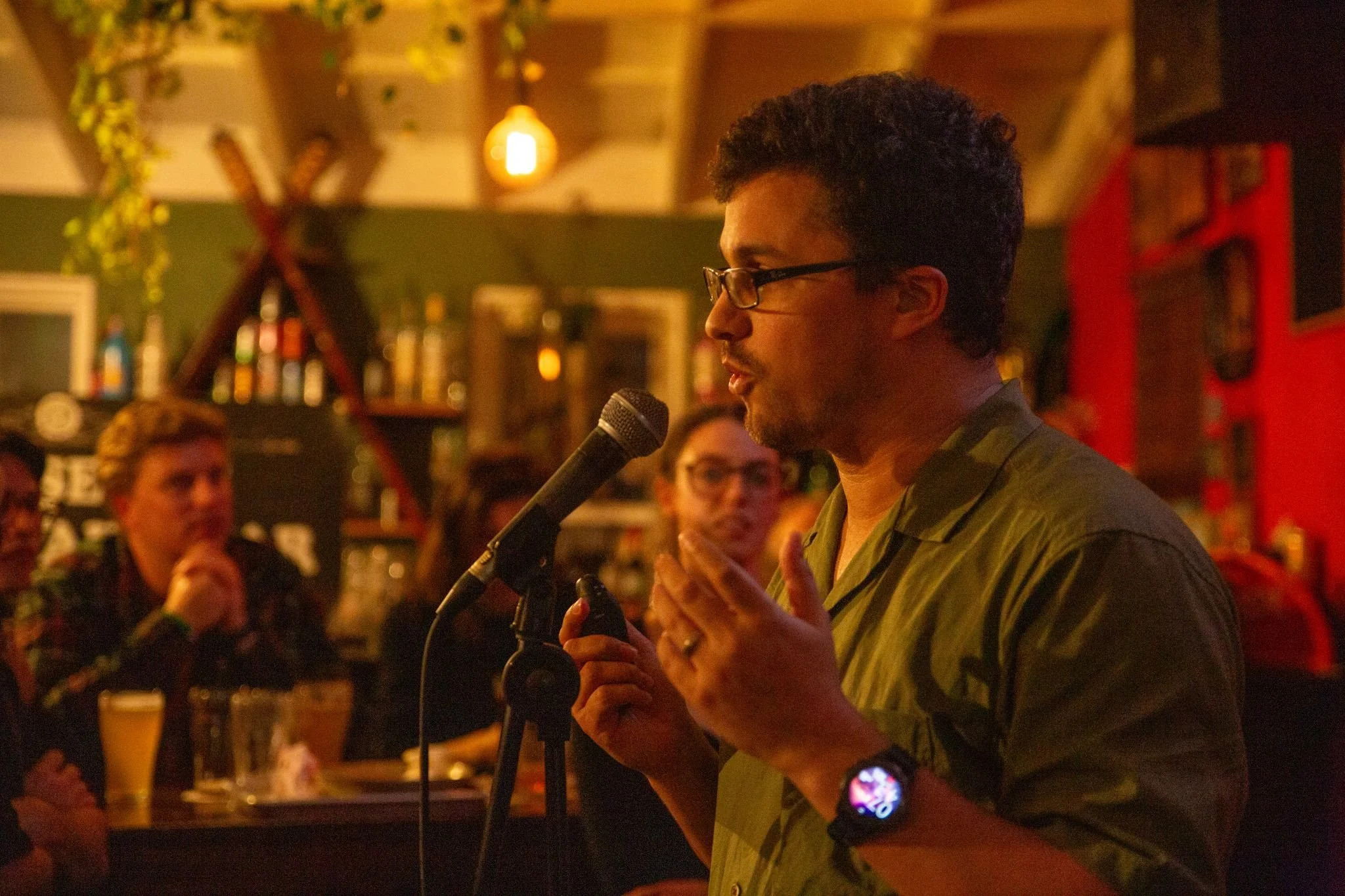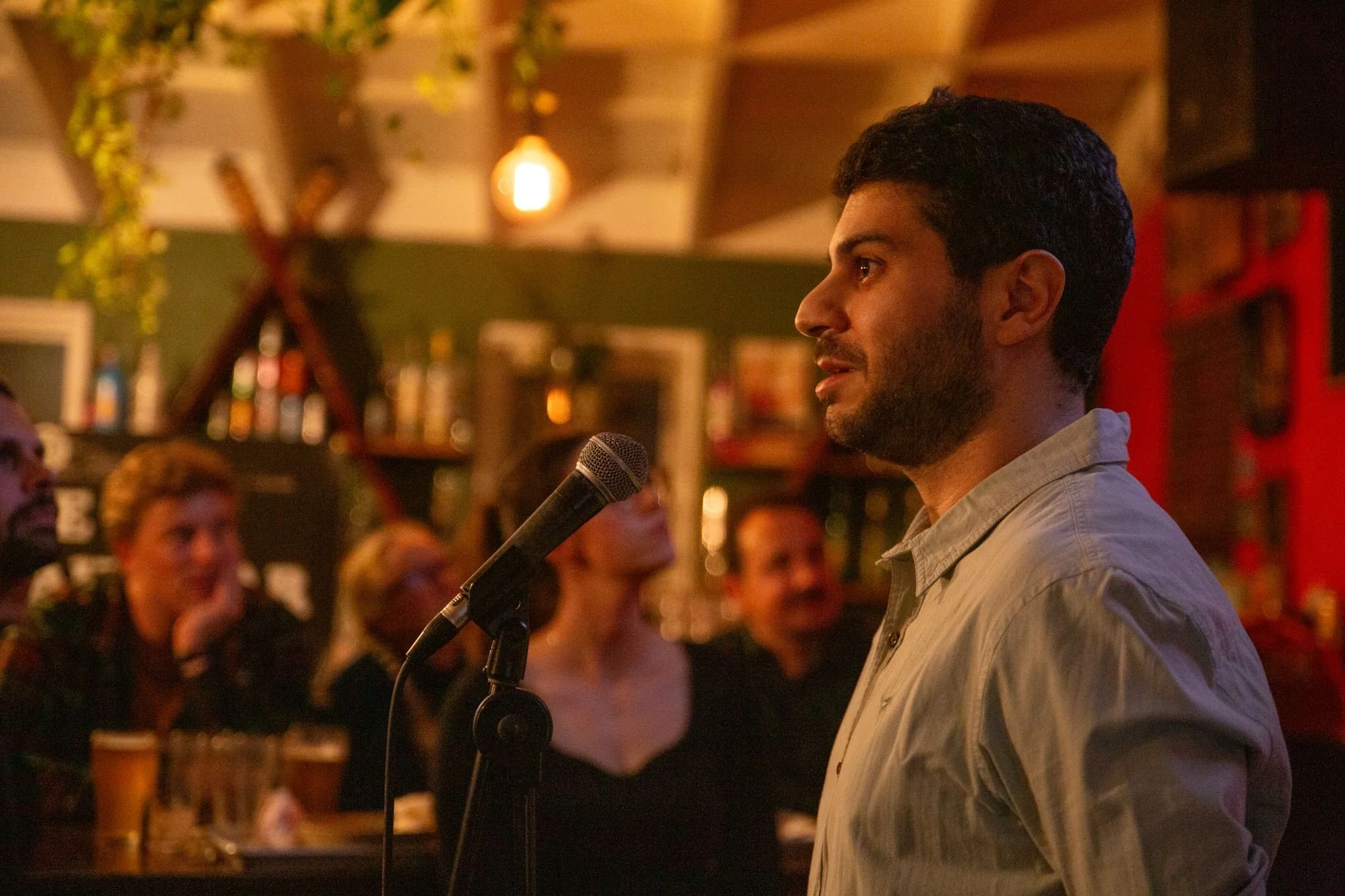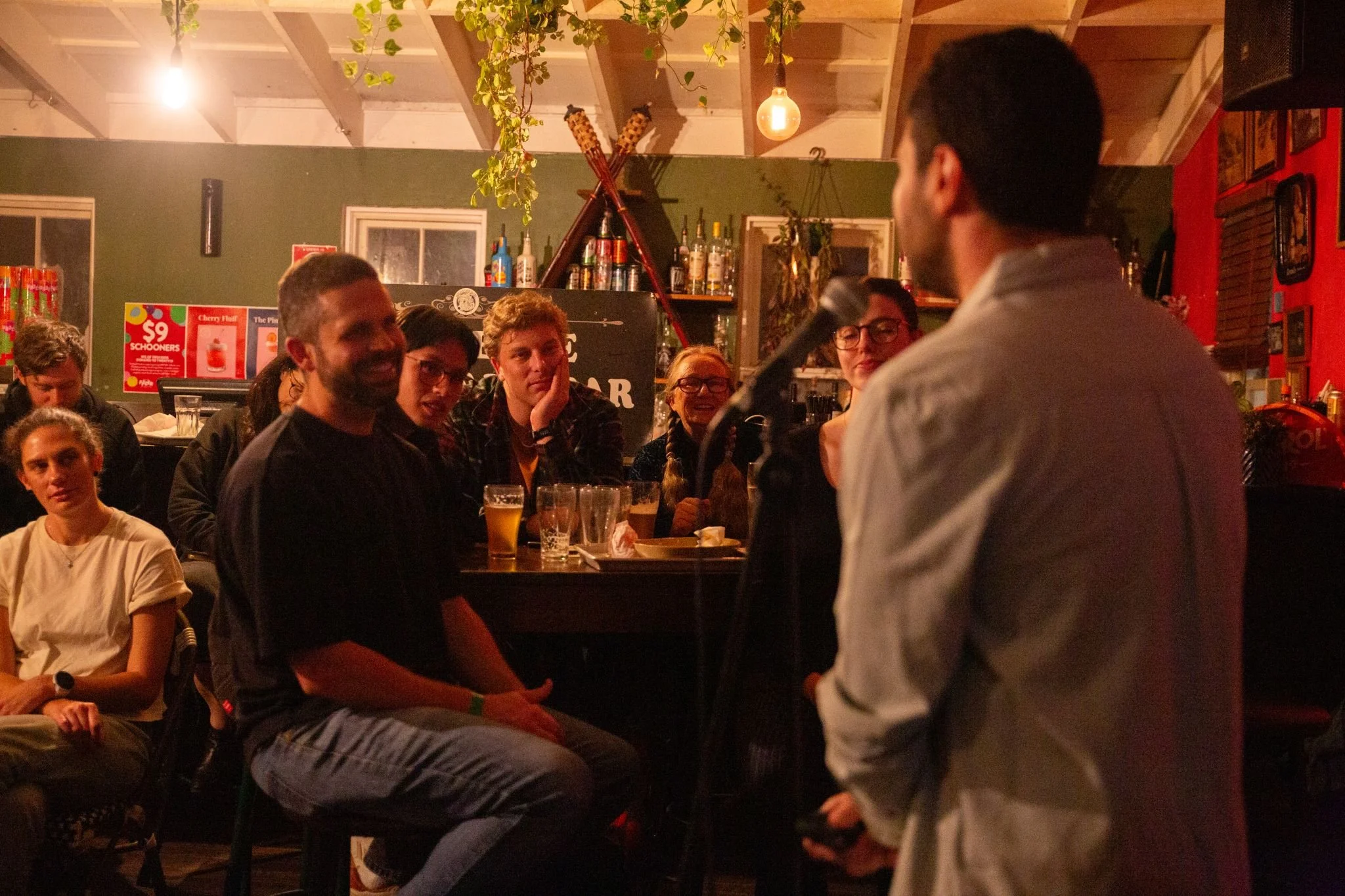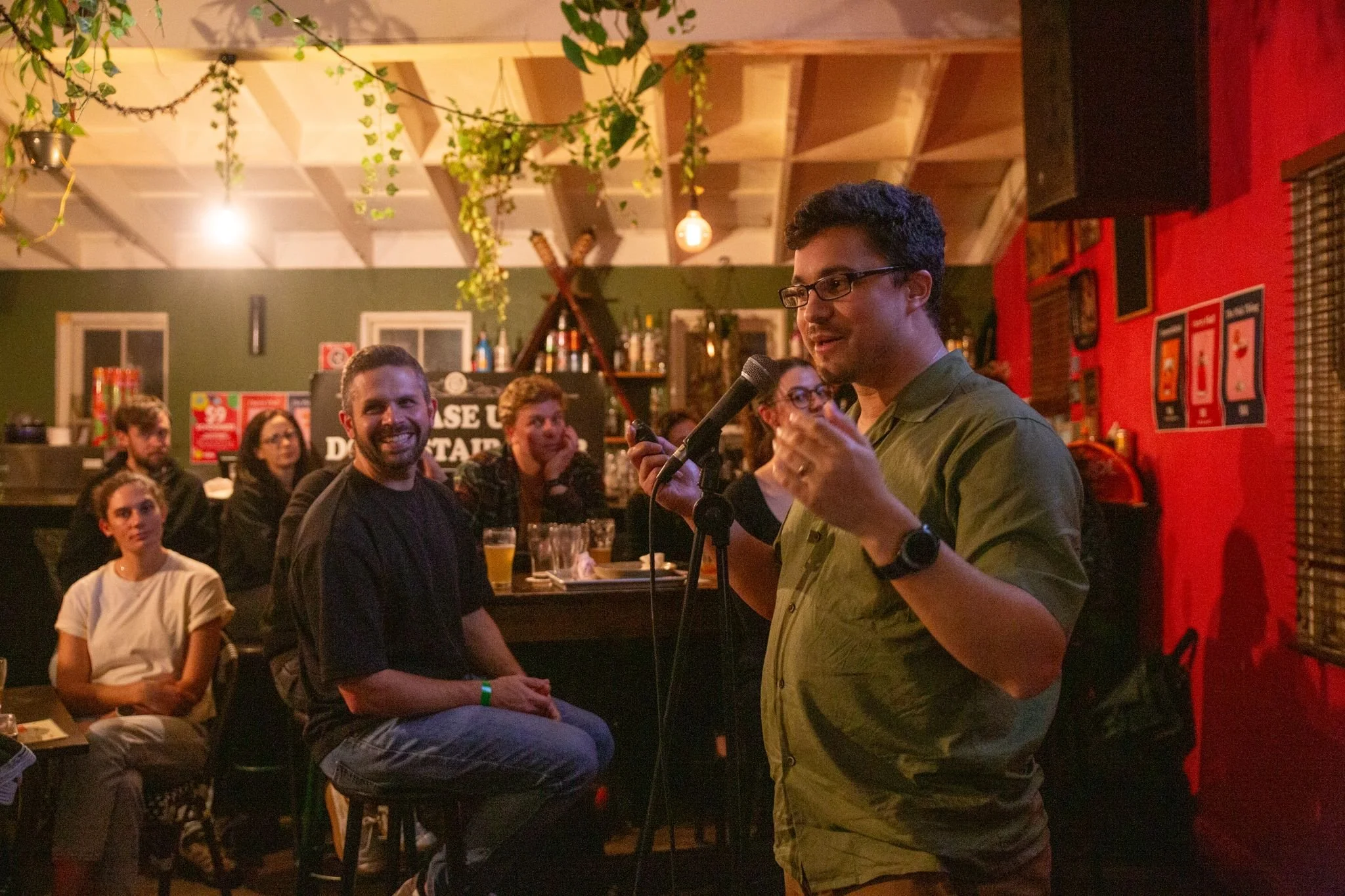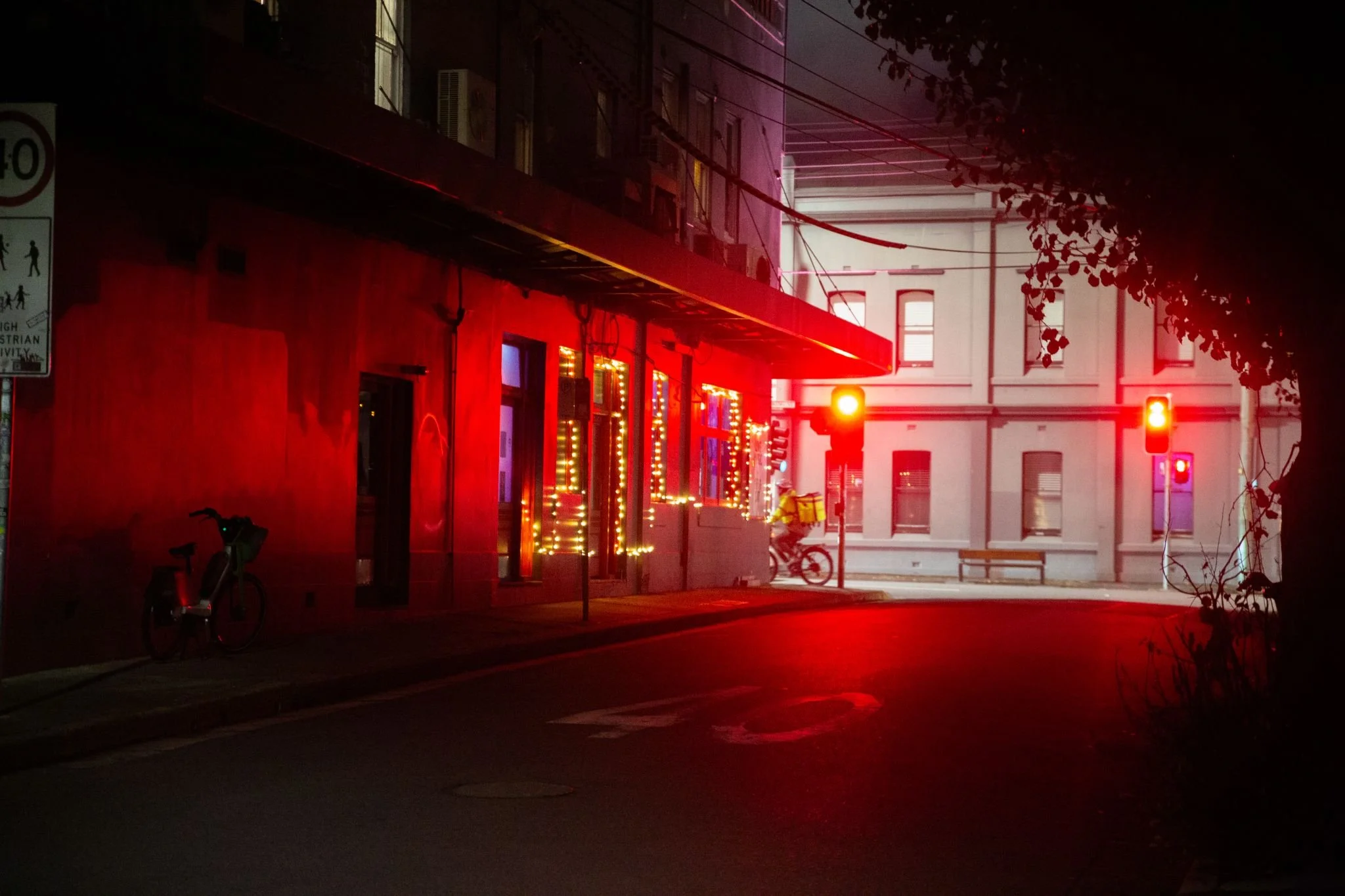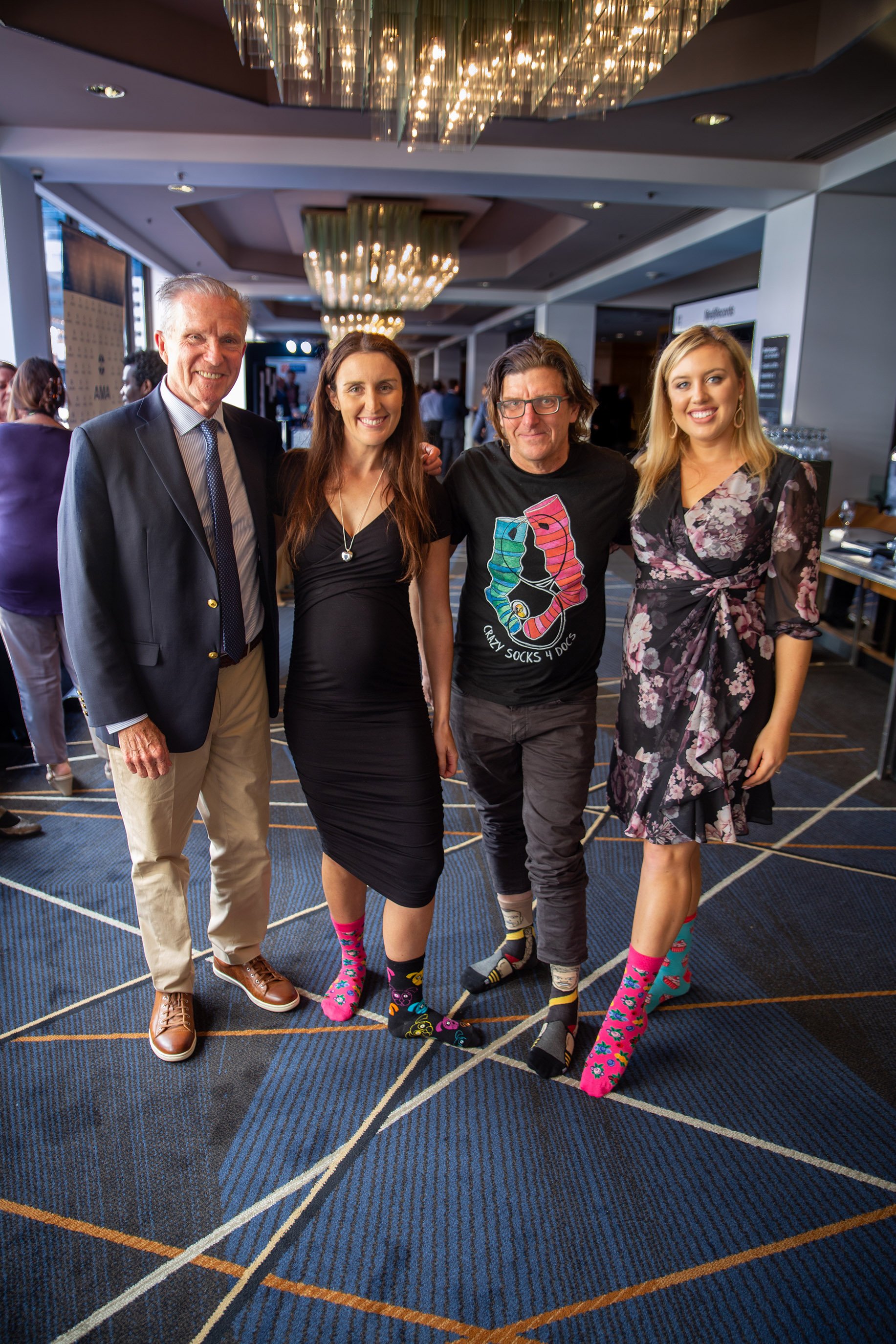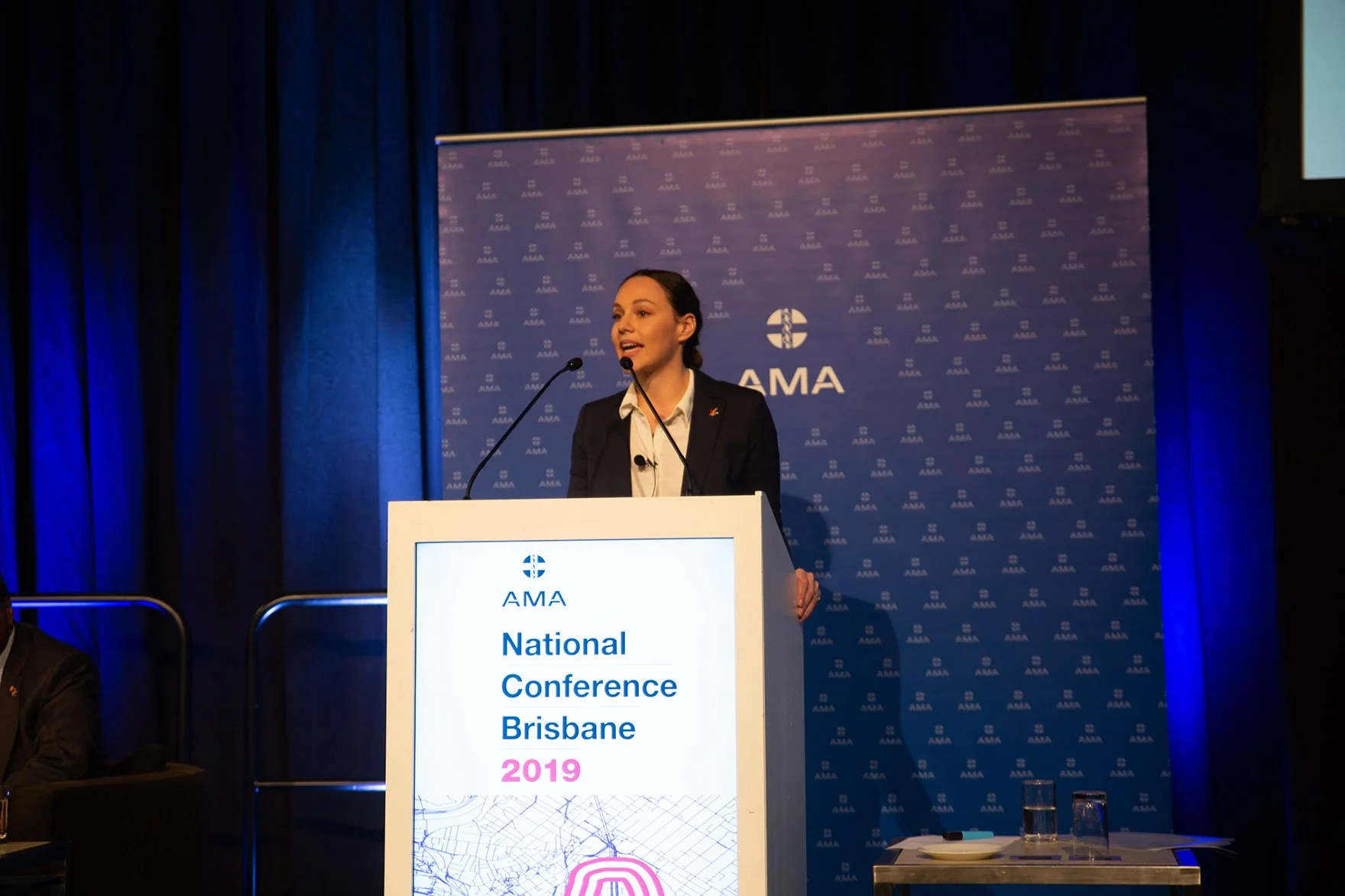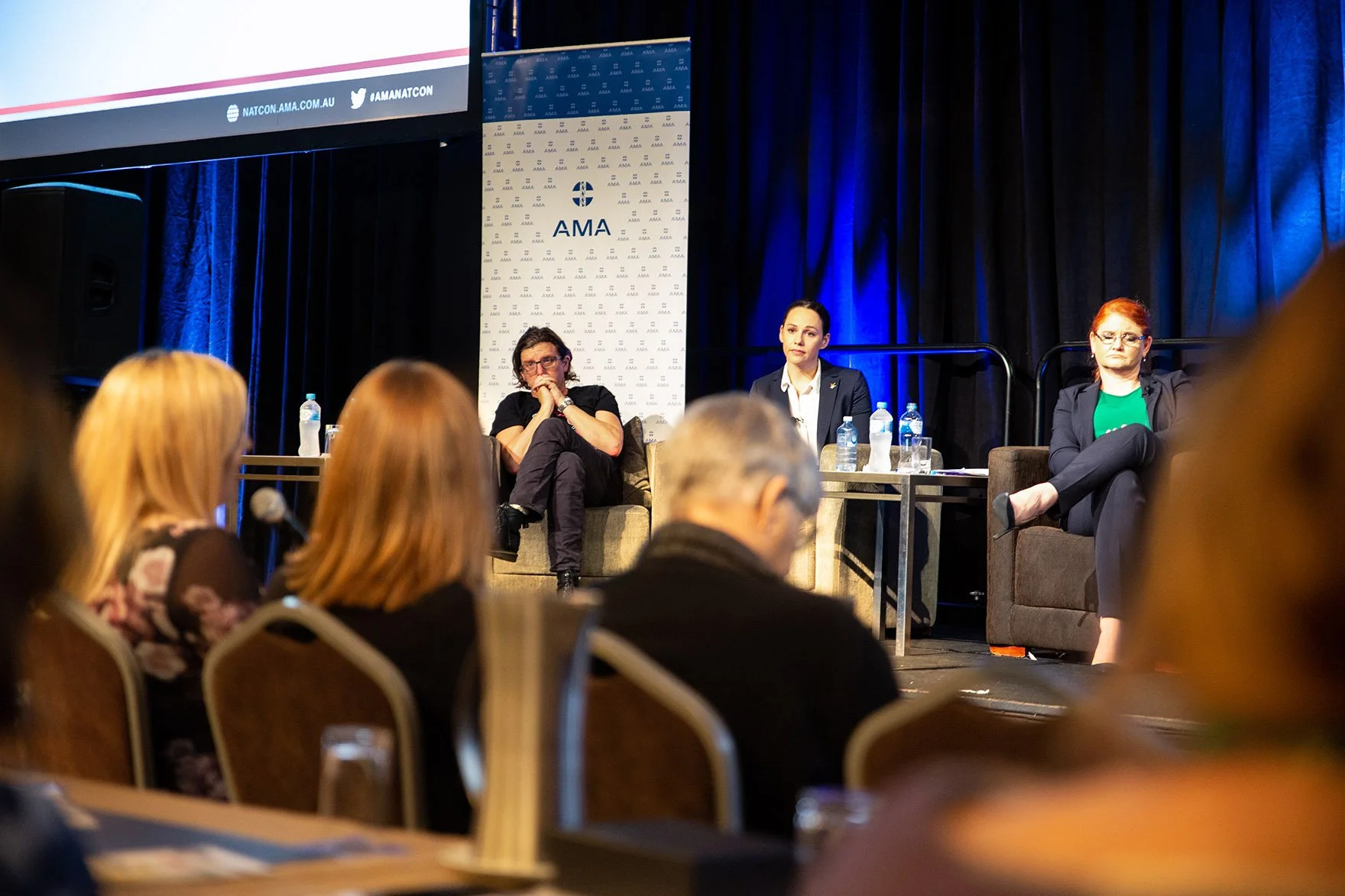
Events coverage
-

News coverage
News-style stories of keynote speeches, including pithy quotes and click-worthy headlines.
-

Live social media
Crafting real-time Twitter, LinkedIn, Facebook, Instagram or Threads posts about keynote speeches and conference buzz.
-

Photography
Speaker & crowd pics with a Canon EOS 50D Mark III
-

Podcast
Producing podcasts from conferences based on interviews with speakers and attendees.
PINT OF SCIENCE AUSTRALIA festival 2025
Australian Medical Association conference 2019
Doctors who have lost colleagues to suicide are demanding that the medical profession make serious structural and cultural changes
Pink, orange, and blue socks – mismatched to maximise the visual clash – were out in force at the AMA conference in Brisbane on Friday.
The #crazysocks4docs advocates had a serious message to send the medical profession: real cultural and structural change is urgently needed to prevent doctor suicide.
“A huge component of prevention is addressing these modifiable stresses,” said Dr Jessica Dean, an intensive care trainee and former AMSA president, in an address to the conference.
“They are appropriate rostering, access to sick leave and other leave entitlements, flexible working conditions, appropriate staffing and appropriate workloads. It isn’t rocket science. We now know exactly what has to be done. We just need to do it.”
Pilots spend 50% of their time resting on long-haul flights, she said. “We are still trying to stamp out the 16-hour shift [at hospitals]. Why do we think we are invincible to fatigue?”
Sitting in the front row at the AMA conference were Micaela and Jessica Abbott, the sisters of Chloe Abbott, a 29-year old junior doctor at St Vincent’s Hospital who died by suicide in 2017.
“When Chloe took her life, it was really close to heart to this organisation,” said former AMA President Dr Mukesh Haikerwal.
“And a lot of the action that we’ve seen has been driven by that. This family has actually changed the language, has changed the dialogue so that we are now talking about [doctor suicide].”
“Thank you so much for having us here,” said Micaela Abbott, addressing the conference. “I have just been sitting listening to this just in awe of everyone’s absolute commitment and dedication to this issue.”
The founder of #crazysocks4docs, cardiologist Dr Geoff Toogood, spoke about stigma and vulnerability.
“The first time I walked into a psychiatric consultation I sat behind a magazine because I feared being seen,” he said.
“I didn’t want people to know that, as a doctor, I’d failed.
“Many colleagues suggested after 15 years or 20 years of clinical practice that perhaps he wasn’t cut out for this job. I should try something else. Or I wasn’t resilient enough, I wasn’t strong enough.
“I thought when I was actually ill and suicidal and not coping that I was the only doctor in the hospital who was like that. But I’ve come to realise, that’s not true.”
Professor Michael Myers, a psychiatrist and author from New York, explained why it was often so hard for some doctors to ask for help.
“Physicians are notorious for beating themselves up for becoming ill,” he said. “When I talk to my doctor-patients about why they don’t have a GP often the first response is – and they say this somewhat laughingly – ‘Oh, I don’t really trust other doctors’. It is said in jest, but I think there’s a little bit in earnest there.
“There’s an inability to accept the patient role. And then there’s hypertrophied altruism – that we give so much to others that we just don’t take care of ourselves. And I say of this without judgment.”
To maintain absolute confidentiality, mental health services for doctors could offer after hours care, in a discrete location with no signage, with at least 15-minutes between appointments, said Melbourne-based psychiatrist Dr Helen Shultz.
Professor Chris del Mar has questioned the value of population-wide flu vaccinations in a controversial presentation at the inaugural GPs Down Under conference.
While influenza was clearly a real threat to public health, annual flu vaccinations did little to protect the population against serious illness, Professor del Mar, a public health expert at Bond University, said.
“It seems to me that public health is overselling the influenza vaccine,” he said.
Speaking at GPDU18, which was held on the Gold Coast May 30 to June 1, Professor del Mar acknowledged the influenza vaccine usually decreased the risk of infection by about 50%, but said the absolute risk reduction was quite low.
He quoted a recently-updated Cochrane review which showed the flu vaccine only reduced the rate of laboratory-confirmed influenza from 2% to 1%.
The meta-analysis of RCTs revealed that nine out of 1,000 people who were vaccinated caught the flu compared with 23 out of 1,000 people who were not vaccinated.
“That’s a very, very small difference,” said Professor del Mar. “For an individual, it probably means you have to be immunised 50 years in a row to save you getting one infection,” Professor Peter Collignon, an infectious disease physician at ANU, told The Medical Republic.
Professor Collignon, who did not speak at GPDU18, questioned the wisdom of pushing everyone in the population, particularly children, to be immunised every year.
There was even some evidence that being infected by wild influenza provided better protection against pandemic flu than yearly vaccinations, he said.
“Having said that, for high-risk people with significant underlying disease, it’s still worth getting the influenza vaccine,” he said. “It may not be perfect, but it’s probably better than nothing.”
The “other side to the coin” was that the influenza vaccine caused febrile convulsions in around one in 100 children who were vaccinated in Australia, and had been linked with at least two deaths, Professor del Mar said.
The Cochrane review, which included 40 years’ worth of data from tens of thousands of healthy adults across North America, South America, and Europe, also showed that the influenza vaccine did not significantly decrease the rate of hospital admissions or deaths from flu.
“So the next question is, if we are not going to promote influenza vaccine, is there anything else we can do instead?” Professor del Mar asked.
Tamiflu might help individual symptoms but it was “pretty hopeless” as a public health response, he said.
Professor Collignon said the most effective intervention against the spread of influenza was hand washing and face masks, which provided around 70 to 80% protection.
But these common-sense measures were not as popular as medications or vaccines. “One of the problems with the modern world is we want an instant answer for everything,” he said.
Allen Cheng, a professor in infectious disease epidemiology at Monash University, told The Medical Republic that the 1 to 2% rate for influenza infections reported by Cochrane was at odds with other studies, which placed the annual global incidence rate of influenza at around 10 to 15%.
PCR-confirmed influenza was also the “tip of an iceberg of illness”, and many people with influenza never visited a GP, he said.
“The 233,000 flu notifications last year [in Australia] almost certainly is an underestimate of the true burden of disease,” he said. The Cochrane review only included healthy adults, who were much less vulnerable than elderly people to complications from influenza, Professor Cheng said.
“I don’t think anyone is arguing against hand washing and masks, but (a) these are more complex and expensive interventions at a population level than a single $10 vaccine and (b) there’s no reason why we can’t do both,” he said.
We asked four local experts what sessions caught their attention at the American Society of Clinical Oncology annual conference.
Dr Lucy Gately, a medical oncologist at WEHI and Cabrini Health who has an interest in neuro-oncology and breast cancer, picked out a session that has received some media attention already – the plenary presentation on the OlympiA trial results.
The OlympiA trial was a phase III, multicenter, randomised, placebo-controlled trial of adjuvant olaparib after (neo)adjuvant chemotherapy in patients with germline BRCA1/2 mutations and high-risk HER2-negative early breast cancer.
Here’s a summary of the trial from Dr Gately:
OlympiA evaluated the role of adjuvant olaparib (a PARP inhibitor) in women with early-stage high risk HER2-negative breast cancer who have inherited mutations in the BRCA1 or BRCA2 genes. At the primary interim analysis of almost 2,000 women, Olaparib taken for 12 months after surgery and chemotherapy improved the primary endpoint of invasive disease-free survival (IDFS) by 42%, increasing 3yr IDFS from 77% to 86%. AEs were consistent with other trials being nausea, fatigue and anaemia. Mature OS and QOL data are pending.
Q: Why did this jump out at you as being interesting or significant?
A: We have seen the importance of PARP inhibitors in advanced BRCA1/BRCA2 mutated cancer types, such as metastatic breast, prostate and ovarian cancer. OlympiA has now demonstrated the utility of using olaparib earlier in the disease course for this subgroup of patients.
Q: How does this relate to the Australian context?
A: Mature OS and QOL data is still pending. Whilst the toxicity is similar to that reported in other trials, the impact of 12 months of adjuvant therapy on quality of life remains important.
Q: How does this connect to broader themes in cancer medicine?
A: This trial further highlights the importance of germline genetic testing early in a patient’s disease course to identify those who may benefit from such therapies. Where previously, genetic testing focused on prevention of cancer and targeted risk assessment, we are now realising its place in instituting personalised oncology. Furthermore, whilst BRCA1/2 mutations are the most common germline mutations in breast cancer, we are still to see the role of PARP inhibitors in other genes that impact the homologous recombination repair pathway such as PALB2, CHEK2, RAD51.
Professor David Thomas, a medical oncologist and researcher at the Garvan Institute of Medical Research with an interest in precision oncology, was drawn to a US abstract titled ‘Palbociclib in patients with soft tissue sarcoma with CDK4 amplification: results from the TAPUR study’.
Here’s a summary from Professor Thomas:
Palbociclib is a CDK4 inhibitor whose single agent activity in cancer is disappointing. However, it may have a role in combinations. The data presented here in 29 patients suggest a cytostatic effect, with only one partial response but a disease control rate of 48%. Similar data have been reported previously, but this has emerged from the TAPUR study, one of the largest precision oncology platform trials in the world.
Q: Why did this jump out at you as being interesting or significant?
A: First, because palbociclib may have some anti-tumour effect in sarcomas. Second this particular study reported on sarcomas, my own area of clinical expertise. Third, because of TAPUR.
Q: How does this relate to the Australian context?
A: Australia also has its own model of TAPUR: MoST. MoST is a national multi-centre precision oncology platform, which also had an arm with palbociclib as a single agent, with similar experiences. We are a partner to the international collaboration led by DRUP and TAPUR, and look forward to combining our data with those of our colleagues.
Q: What does this make you reflect on?
A: The need for national and international precision oncology collaborations to identify opportunities for novel therapies.
Associate Professor Rob Carroll, a nephrologist at The University of South Australia with an interest in cancer after organ transplant, shared his thoughts on an abstract his team submitted to ASCO on nivolumab for incurable cancer after renal transplant safety and efficacy.
Here’s a summary from Professor Carroll:
Immune checkpoint inhibitors have been associated with high levels of organ transplant rejection. In this study, the authors continued baseline immune suppression and exposed renal transplant patients to immune checkpoint inhibitors. Only two out of 15 patients suffered rejection and both were salvaged with plasma exchange the complete response and partial response was around 50%. It seems there for that continuing immune suppression reduces the risk of rejection but does not affect efficacy.
Q: What’s interesting about this study?
This is a study showing that continuing immunosuppression results in much lower rates of rejection compare to previous case reports. It means we can use immune checkpoint inhibitors in organ transplantation with certain protocols.
Q: What does this make you reflect on?
That case series data may have over-represented the risk of rejection for immune checkpoint inhibitors in organ transplant.
Associate Professor Liang Qiao, a translational cancer researcher at the University of Sydney and the Westmead Institute for Medical Research with an interest in liver diseases, liver cancer and GI cancer, found abstract e16129 interesting.
This was American research on the real-world effectiveness of lenvatinib monotherapy among previously treated unresectable hepatocellular carcinoma patients.
Here’s a summary from Professor Qiao:
Envatinib monotherapy was approved in August 2018 for first-line treatment of patients with unresectable hepatocellular carcinoma (uHCC). In this real-world data study, the efficacy of lenvatinib monotherapy was assessed on 164 patients with uHCC (as a second- or later-line systemic therapy) was assessed. Lenvatinib was used at a dose of 12 mg/day for a median duration of 6.9 months. At the end of follow up, 43% of patients remained on lenvatinib. Patients were assessed for: best response (provider-reported), progression-free survival (PFS), and overall survival (OS). Complete response (CR) was seen in 9%, partial response (PR) in 45% and stable disease (SD) in 26% of patients. Median PFS was 12.5 months; median OS was 14 months. At six months, landmark PFS was 71% and landmark OS was 84%. At 12 months, the landmark PFS was 52% and landmark OS was 58%. Thus, lenvatinib monotherapy has clinical effects in previously treated uHCC patients, including those received with prior immunotherapy.
Q: Why did this jump out at you as being interesting or significant?
A: Advanced liver cancer has no cure. Given a constant increase in the incidence of mortality of primary liver cancer in Australia, more efficient therapies are urgently needed. Envatinib has already been approved as a first line agent for advanced HCC. The current report also demonstrated that this agent has clinical effects as the second line therapy.
Q: How does this relate to the Australian context?
A: HCC is one of the fastest growing cancers in Australia, in terms of incidence and mortality. No effective therapies are available. This study provides insights to clinicians that lenvatinib monotherapy can be considered as the first- or second-line approach for patients with advanced HCC.
Q: How does this connect to broader themes in cancer medicine?
A: New therapies are constantly developed. Any approaches that can improve patient survival would “buy time” for the patients who might later benefit from the newer therapies.
The study results we’ve all been waiting for – part 2 of the GiACTA trial – have been announced at EULAR, but there were still a few “unanswered questions”, an Australian rheumatologist says.
Part 1 of the GiACTA trial, reported in NEJM in 2017, examined the effect of a one-year course of tocilizumab in around 250 patients with giant cell arteritis.
The trial found that a weekly or fortnightly dose of tocilizumab given for 52 weeks could put over half of GCA patients into glucocorticoid-free remission.
At the one-year mark, patients stopped the biologic therapy.
The trial results unveiled by Harvard University rheumatologist Professor John Stone at EULAR last week showed what happened during the two-year extension of the GiACTA trial.
Professor Stone reported that nearly half of these patients stayed in steroid-free remission for the second part of the trial.
Over 50% of patients in the tocilizumab group relapsed in the second and third years of the GiACTA trial.
But patients who had a flare were treated with another course of tocilizumab, which put them back into clinical remission.
Finding a replacement for steroids has long been a goal in GCA research because steroids have devastating side effects in older women, raising the risk of osteoporosis and fractures.
The study was particularly relevant for Australian rheumatologists as tocilizumab for GCA was recently pushed along to the next stage of the PBS approval process by PBAC and could soon be affordable for patients.
However, the GiACTA trial left rheumatologists with some “unanswered questions”, said Professor Catherine Hill, a rheumatologist based in Adelaide and the vice-president of the Australian Rheumatology Association.
The GiACTA trial had a 20% drop-out rate, with only 197 patients completing the three years.
“And even though it was a lot of patients in the beginning, when you start dividing it into four groups … it starts to get quite small and it starts to become a bit more difficult to interpret the results,” Professor Hill told Rheumatology Republic.
“The other thing from the first part of the trial was it seemed that the patients who were recently diagnosed had slightly different results from those patients who relapsed. The patients who got into the trial on a relapse didn’t seem to respond to the lower dose of tocilizumab.
“That wasn’t really different to placebo. In the results that Professor Stone showed today, he didn’t sub-divide them by whether they had entered GiACTAas newly-diagnosed or relapsed. So, I think that’s another query.”
The GiACTA trial also didn’t provide guidance on whether tocilizumab should be tapered or withdrawn after 12 months in patients with GCA, said Professor Hill.
“[This] is quite attractive to rheumatologists because we would think about weaning the steroids as quick as possible and then perhaps weaning tocilizumab,” she said.

